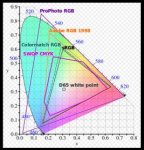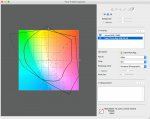I'm new to this forum ... I trying to understand what I need to do to take my prints to the next level. Hopefully someone here can help or point me in a better direction. ...
I'm trying to get my head around how in practice differences in the dynamic range of camera sensors maps to the reduced dynamic range/DMAX of a final print.
I'm using a matte fine art cotton paper ( Hahnemule 308) and having it professionally printed.
So if a sensor offers, say, 1EV extra dynamic range (DR), then a greater tonal range can be captured. If this is processed, say in ProPhoto at 16-bit to ensure any processing losses are minimised, before mapping to Adobe 1998 and 8-bit for printing, then clearly some of the advantage of the greater initial DR from the sensor is going to be lost. This range is further reduced when printed.
So my question in simplified terms, to try and help me quantify what happens in practice: How much of the tonal range captured in a camera with a greater DR range is actually still visible when printed ? (I appreciate, that the framing glass used and viewing conditions will further affect/reduce the viewers experience and final processing needs to be done for specific paper characteristics.)
Any guidance will be greatly appreciated.
I'm trying to get my head around how in practice differences in the dynamic range of camera sensors maps to the reduced dynamic range/DMAX of a final print.
I'm using a matte fine art cotton paper ( Hahnemule 308) and having it professionally printed.
So if a sensor offers, say, 1EV extra dynamic range (DR), then a greater tonal range can be captured. If this is processed, say in ProPhoto at 16-bit to ensure any processing losses are minimised, before mapping to Adobe 1998 and 8-bit for printing, then clearly some of the advantage of the greater initial DR from the sensor is going to be lost. This range is further reduced when printed.
So my question in simplified terms, to try and help me quantify what happens in practice: How much of the tonal range captured in a camera with a greater DR range is actually still visible when printed ? (I appreciate, that the framing glass used and viewing conditions will further affect/reduce the viewers experience and final processing needs to be done for specific paper characteristics.)
Any guidance will be greatly appreciated.











